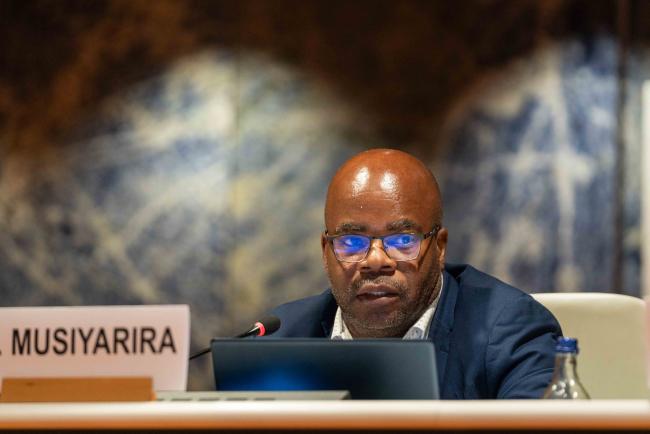The final day of the 20th Annual General Meeting (AGM) of the Intergovernmental Forum on Mining, Minerals, Metals and Sustainable Development (IGF) included IGF’s first-ever session on non-metallic minerals (NMMs) and their place in sustainable development. Other sessions examined regional dialogue for mineral supply chains, disruptive technologies changing how mining is done, and ideas, opportunities, and pathways for mining to support a better future.
The NMMs session opened with Uyanga Gankhuyag, African, Caribbean, and Pacific (ACP)-European Union (EU)-UN Development Programme (UNDP) Development Minerals Programme, discussing the opportunities and advantages linked to NMMs, particularly in ACP countries. Arsène Patoingnimi Tiendrebeogo, Director General of Quarries, Burkina Faso, presented on the socioeconomic, environmental, and practical benefits of building with stabilized earth bricks in his country with support from the ACP-EU-UNDP Development Minerals Programme.
Naomi Nangoku, Uganda, pointed out that artisanal and small-scale mining (ASM) enterprises produce 83% of NMMs in her country. She highlighted her government’s efforts to bring these actors into the formal economy through outreach, capacity-building, and regulations.
Louise Gallagher, University of Queensland, emphasized that annual global sand and silicates consumption volumes are around 70,000 times greater than typical high-profile minerals. However, the social and environmental risks linked to their extraction and use are often overlooked.
In the regional dialogue session, Oluwatoyin Ojo, African Legal Support Facility (ALSF), explained how ALSF provides legal advice and technical assistance to African countries in negotiating complex commercial contracts and agreements.
Harmony Musiyarira, Namibia University of Science and Technology, discussed how Namibia, with its ports, minerals, and the development of green hydrogen in cooperation with the EU, is well placed to serve in Southern African Development Community (SADC) efforts to develop regional mineral supply chains.
Maureen Coulas, Natural Resources Canada, discussed how Canada works with Latin America and the EU through strategic collaborations on critical minerals that emphasize advancing joint research and development; improving the resilience of critical mineral value chains; aligning policies; raising environment, social, and governance (ESG) standards; and fostering new investment opportunities.
Thomas Scurfield, Natural Resources Governance Institute (NRGI), called for more transparency on state-state critical minerals partnerships, and warned of the ways in which such partnerships could, at times unintentionally, hinder regional collaboration on mineral supply chains.
In the disruptive technologies session, Tracey Cooper, Facilitator, Member of Advisory Boards, reviewed key findings from the new IGF report, Leveraging Digital Infrastructure for Mining Community Resilience. Hans van ‘t Spijker, Witteveen+Bos, discussed a case study on technologies for extracting lithium from geothermal brines while generating power. Ashleigh Maritz, Ivanhoe Mining, discussed a hydropowered-smelter in the Democratic Republic of Congo (DRC) that reduces greenhouse gas emissions and a DRC zinc-copper-germanium-silver mine where refurbishing and new technologies allowed for enhanced underground safety and ultimately increased production.
Lisl Pullinger, Managing Director, Vivid Advisory, stressed that while technology advancement may raise concerns about employment security, open dialogue and investing in workers’ skills are critical for efficient and sustainable operations. Pullinger also emphasized how technologies can be a catalyzer to remove gender barriers and allow more women to enter the sector.
In the final session, panelists reflected on future pathways. Anna Apler, Geological Survey of Sweden, called for “equity and equality for the people of the world” and for “thinking beyond the immediate future.” She stressed that “mining companies should pay for mine closures—not taxpayers, the economy, or the planet.”
Katherine Gosselin, Director, Mining Association of Canada, highlighted the various roles of standards, including in helping companies anticipate stakeholders’ expectations and bridging the gap between international standardization and contextual realities.
Junior Lodge, Organisation of ACP States (OACPS), highlighted the paradox faced by most ACP states: mineral wealth but acute poverty. He underscored the need to provide ASM workers with a proper governance framework with health, environmental, and labor standards.
Luz María de la Mora, UN Trade and Development (UNCTAD), stressed the need for a mix of policies to ensure developing countries retain as much value as possible from their own mineral resources.
To receive free coverage of global environmental events delivered to your inbox, subscribe to the ENB Update newsletter.
All ENB photos are free to use with attribution. For the 2024 IGF AGM please use: Photo by IISD/ENB | Mika Schroder






















































